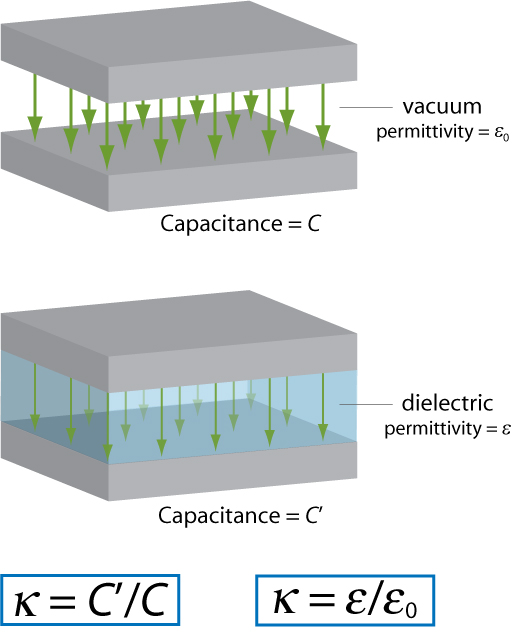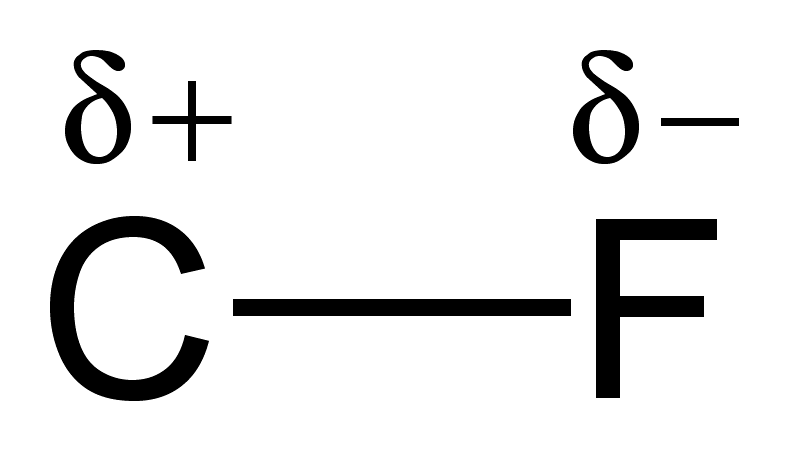Difference Between Dielectric Constant and Polarity
What is Dielectric Constant?
Dielectric constant is the ability of a certain material to store, under the influence of an electric field, electrical potential energy. It is also called permittivity.
Dielectric permeability is a physical property describing how the electric field influences the dielectric environment and how it changes itself as a result of this interaction.
Dielectric permeability is determined by the ability of a certain material to polarize as a result of an applied electric field and, in this respect, to partially neutralize the electric field in the material. Therefore, dielectric permeability refers to the property of the material to conduct (or allow the presence of) the electric field, i. e. it refers to the so-called electrical receptivity.
Dielectric permeability is associated with a number of other physical properties such as electrical capacitance and speed of light. For example, in a capacitor, the use of a material with a higher dielectric permeability allows a given electrical charge to accumulate at less voltage, resulting in a higher capacity of the capacitor at equal other parameters.
The dielectric constant coincides with the relative dielectric permeability in a homogeneous medium and is defined as the ratio of the dielectric permeability of the medium (ε) to the dielectric permeability in a vacuum (ε0).
εr = ε / ε0
The dielectric permeability in a vacuum is one of the fundamental constants in physics. It equals to the ratio of the electric induction (D) to the intensity of the electric field (E) in a vacuum.
ε0 = D/ E = ≈ 8,8541878176 x 10 -12 F/m,
It can also be defined as the ratio of the capacitance of a capacitor with a certain dielectric between the plates and the capacitance of the same capacitor with a vacuum between the plates.
It can be measured directly with specialized devices.
What is Polarity?
Polarity is the condition or quality of an object that has opposite powers or properties in opposite directions or parts or that exhibits contrasted powers or properties in contrasted parts or directions.
Polarity is a widely applied term, used in geometry, biology, chemistry, physics, electronics, etc.
In the electric circuits, there are two poles – positive and negative. In direct current (DC) electric circuits, the polarity does not change, whereas in alternating currents (AC) electric circuits it changes many times depending on the frequency of the electricity.
Imagine that a constant electric potential exists between two objects. In this case, one of these objects (poles) has more electrons, compared to the other. The pole with fewer electrons has a positive polarity, while the pole with more electrons has a negative one. If these two objects are connected by a conductive bond, electrons from the negative pole will flow to the positive one, creating an electric current.
In DC systems, it is important to observe the polarity when switching on a device, as otherwise there may be problems with its operation. Many electronic devices can be damaged by reversing polarity.
The polarity may be determined experimentally by using carbon or metallic electrode.
Difference Between Dielectric Constant and Polarity
-
Definition
Dielectric Constant: Dielectric constant, called also permittivity, is the ability of a certain material, under the influence of an electric field, to store electrical potential energy.
Polarity: Polarity is the condition or quality of an object that has opposite powers or properties in opposite directions or parts or that exhibits contrasted powers or properties in contrasted parts or directions.
-
Basis
Dielectric Constant: The dielectric constant is determined by the ability of the electric field to influence the dielectric environment and to change as a result of this interaction.
Polarity: The polarity is determined by opposite powers or properties in opposite directions or parts of a body. The electrical polarity is determined by the different amount of electrons in the two poles.
-
Importance
Dielectric Constant: The dielectric materials are poor conductors of electric currents, but can support efficiently electrostatic field.
Polarity: In certain conditions, the polarity creates an electric current.
-
Value
Dielectric Constant: The dielectric constant equals to the ratio of the electric induction (D) to the intensity of the electric field (E) in a vacuum.
Polarity: In the electric circuits, there are two poles – positive and negative.
-
Determination
Dielectric Constant: Dielectric constant can be calculated by the ratio of the dielectric permeability of the medium to the dielectric permeability in a vacuum. It can be measured directly with specialized devices.
Polarity: The polarity may be determined experimentally by using carbon or metallic electrode.
Dielectric Constant vs Polarity: Comparison Table
Summary of Dielectric Constant vs Polarity:
- Dielectric constant is the ability of a certain material, under the influence of an electric field, to store electrical potential energy.
- Polarity is the condition or quality of a body that has opposite powers or properties in opposite directions or parts or that exhibits contrasted powers or properties in contrasted parts or directions.
- The dielectric constant is determined by the ability of the electric field to influence the dielectric environment and to change as a result of this interaction. The polarity is determined by the presence of opposite powers or properties in opposite directions or parts of a body. The electrical polarity is determined by the different amount of electrons in the two poles.
- The dielectric materials can support efficiently electrostatic field. In certain conditions, the polarity creates an electric current.
- The dielectric constant equals to the ratio of the electric induction (D) to the intensity of the electric field (E) in a vacuum. In the electric circuits, there are two poles – positive and negative.
- Dielectric constant can be calculated by the ratio of the dielectric permeability of the medium to the dielectric permeability in a vacuum. It can be measured directly with specialized devices. The polarity may be determined experimentally by using carbon or metallic electrode.
- Difference Between Gallstones and Cholecystitis - September 5, 2021
- Difference Between Constipation and Cramping - August 4, 2021
- Difference Between Whole Genome Sequencing and Microarray - May 6, 2021
Search DifferenceBetween.net :
Leave a Response
References :
[0]Image credit: https://commons.wikimedia.org/wiki/File:Carbon-fluorine-bond-polarity-2D-black.png
[1]Image credit: https://commons.wikimedia.org/wiki/File:Dielectric-constant.jpg
[2]Halliday, D. Resnick. Fundamentals of Physics Textbook. Hoboken: Wiley. 2004. Print.
[3]Kuchling, H. Physics. Moscow: Mir. 1982. Print.
[4]Ryan, Ch. Basic Electricity: A Self-Teaching Guide. New York: John Wiley & Sons Inc. 1986. Print.



